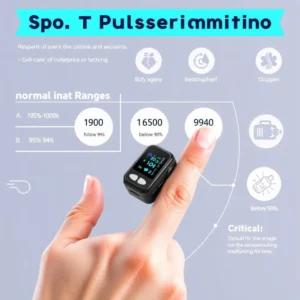SpO2 Normal Range Chart: Finger Pulse Oximeter Readings Explained
When it comes to monitoring your health, understanding your blood oxygen levels is crucial. But what is the SpO2 normal range for finger pulse oximeter readings, and how can you interpret the results? Whether you’re managing a chronic condition, recovering from an illness, or simply curious about your health, this guide will walk you through everything you need to know about SpO2 levels, pulse oximeters, and how to use them effectively.
What is SpO2? Understanding the Basics
SpO2, or peripheral capillary oxygen saturation, measures the amount of oxygen in your blood. It’s expressed as a percentage and indicates how well oxygen is being transported to your extremities. A finger pulse oximeter is a small, non-invasive device that clips onto your finger to measure SpO2 levels and heart rate.
Key Points About SpO2:
- Normal Range: For most healthy individuals, the SpO2 normal range is between 95% and 100%.
- Hypoxemia: Levels below 90% are considered low and may indicate hypoxemia, a condition where your body isn’t getting enough oxygen.
- Critical Levels: An SpO2 level below 80% is dangerous and requires immediate medical attention.
For more details on what constitutes a normal oxygen level, check out our article on What is the Normal Range for Oximeter?.
SpO2 Normal Range Chart: What Do the Numbers Mean?
To better understand your readings, refer to the SpO2 normal range chart below:
| SpO2 Level | Interpretation |
|---|---|
| 95% – 100% | Normal |
| 90% – 94% | Below Normal (Consult a Doctor) |
| Below 90% | Critical (Seek Immediate Medical Help) |
Factors Affecting SpO2 Readings:
- Altitude: Higher altitudes can cause lower SpO2 levels due to reduced oxygen in the air.
- Health Conditions: Chronic lung diseases, anemia, or heart conditions can impact readings.
- Device Accuracy: Ensure your pulse oximeter is FDA-approved and properly calibrated.
For a deeper dive into how altitude affects oxygen levels, visit What Happens When Your Oxygen Level Drops to 70?.
How to Use a Finger Pulse Oximeter Correctly
Using a pulse oximeter is simple, but proper technique ensures accurate readings. Follow these steps:
- Prepare Your Finger: Remove nail polish or artificial nails, as they can interfere with readings.
- Position the Device: Clip the oximeter onto your index or middle finger.
- Stay Still: Keep your hand steady and avoid moving during the measurement.
- Wait for Results: The device will display your SpO2 level and heart rate within seconds.
Tips for Accurate Readings:
- Warm your hands if they’re cold.
- Avoid using the device immediately after exercise.
- Compare readings over time to identify trends.
For more tips on choosing the right device, read Which Finger Oximeter is Most Accurate?.
What Causes Low SpO2 Levels?
Low oxygen saturation can result from various factors, including:
- Respiratory Issues: Asthma, COPD, or pneumonia.
- Cardiovascular Problems: Heart failure or poor circulation.
- Environmental Factors: Smoke inhalation or carbon monoxide poisoning.
If you’re experiencing consistently low SpO2 levels, consult a healthcare professional. Learn more about the causes of low oxygen levels in our article What is the Most Common Cause of Low Blood Oxygen?.
How to Improve Your SpO2 Levels
If your SpO2 levels are below normal, here are some actionable steps to improve them:
- Practice Deep Breathing: Techniques like diaphragmatic breathing can enhance oxygen intake.
- Stay Hydrated: Proper hydration improves blood flow and oxygen delivery.
- Exercise Regularly: Physical activity boosts lung capacity and circulation.
- Use Supplemental Oxygen: If prescribed by a doctor, oxygen therapy can help maintain healthy levels.
For more tips on improving blood oxygen levels, check out How to Improve Blood Oxygen Levels.
Common Questions About SpO2 and Pulse Oximeters
1. Can a Pulse Oximeter Detect Blood Pressure?
No, pulse oximeters measure oxygen saturation and heart rate, not blood pressure. For blood pressure monitoring, you’ll need a separate device. Learn more in Can an Oximeter Detect Blood Pressure?.
2. What is a Good Pulse Ox Rate by Age?
Normal SpO2 levels are consistent across ages, but heart rates vary. For example, infants have higher heart rates than adults. Explore this topic further in What is a Good Pulse Ox Rate by Age?.
3. What Are Three Conditions That Can Give a False Pulse Oximetry Reading?
- Cold fingers.
- Nail polish or artificial nails.
- Poor circulation.
For more details, visit What Are Three Conditions That Can Give a False Pulse Oximetry Reading?.
Conclusion: Stay Informed and Take Action
Understanding your SpO2 levels is a vital part of maintaining your health. By using a finger pulse oximeter and referring to the SpO2 normal range chart, you can monitor your oxygen saturation and take proactive steps to address any issues.
If you have concerns about your readings or need personalized advice, don’t hesitate to reach out to us. Visit our Contact Page or message us on WhatsApp for expert guidance.
By following this guide, you’ll not only understand your SpO2 readings but also take actionable steps to improve your health. Stay informed, stay healthy!

